Examples of PLG Companies That Have Leveraged Content to Drive Organic Growth
Examples of PLG Companies That Have Leveraged Content to Drive Organic Growth
Examples of PLG Companies That Have Leveraged Content to Drive Organic Growth
Take a look at what top PLG companies are doing with their content to drive conversions and organic growth.
Take a look at what top PLG companies are doing with their content to drive conversions and organic growth.
Take a look at what top PLG companies are doing with their content to drive conversions and organic growth.
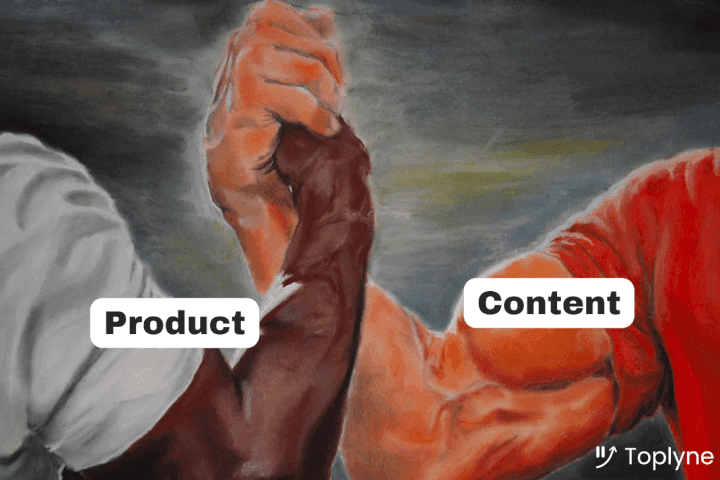


Product-led growth (PLG) is in no way a new trend in the SaaS industry.
Many of the leading SaaS companies have been successfully using the PLG strategy for quite some time now.
And this has helped them accelerate and achieve organic growth.
By placing their product front and center and not gate-keeping it, they’ve been able to attract, convert, and retain their customers.
By opening up the floodgates via a freemium or free-trial motion, PLG companies have been able to –
Lower their CACs (customer acquisition costs)
Achieve a higher retention rate
Improve customer satisfaction
Collect critical product usage data
So, what does it take to build an effective content strategy to drive organic growth?
To get to the bottom of this, we examined how some of the most successful PLG companies are leveraging content through product-led content. Let’s dive in.
Content: A Lever for Growth for PLG companies
When it comes to achieving product-led growth, it’s essential to understand that your content needs to drive experience.
The goal here is not just to deliver a message but to deliver something of value to your prospects.
Ideally, your target audience would want to learn something new from the content, with a takeaway that matches their intent.
This not only helps in proving your expertise but also positions your PLG company as a thought leader in the industry.
So, how do you create quality content that delivers value?
1. Narrative
Start by building a narrative around your brand, and apply this narrative consistently across all content forms.
With this approach, you’ll be able to demonstrate your company’s value before you get to the product.
It also helps in building the trust of the audience.
Be sure to keep your ideal customer persona (ICP) and the problem you help solve for them at the center of your narrative.
2. Simplicity
The best way to make your content more attractive to the audience is by keeping it simple.
The problem that many companies end up making is overcomplicating their content, whether in the form of visuals or copy.
It’s always better to strive for simplicity and conciseness when crafting content.
3. Consistency
Every content produced by a company should deliver on the brand narrative.
Even if the content is distributed through different formats, it should have a common thread running through all of it.
If it doesn’t, it can leave your audience confused.
Say your blog post conveys one message, but your landing page says something else.
Without maintaining consistency, you stand the chance of converting your prospects.
Now, let’s look at the examples of a few PLG companies that have managed to do this successfully.
PLG Companies Nailing Content to Drive Organic Growth
1. ClickUp’s Content Strategy
Founded in 2017, ClickUp is a project management platform that has managed to scale the heights of success quickly. This PLG company grew its ARR from $0 to $20 million in just 2 years.
How did it do that? ClickUp built a solid product and hit the nail on the head with its unique content marketing strategy.
If you look at the ClickUp blog, you’ll find that most of the content is product-led, where they’ve discreetly placed their product, guiding the users through its various use cases. But at the same time, they are also ensuring they deliver something of value. Take a look at this blog by ClickUp, for instance –
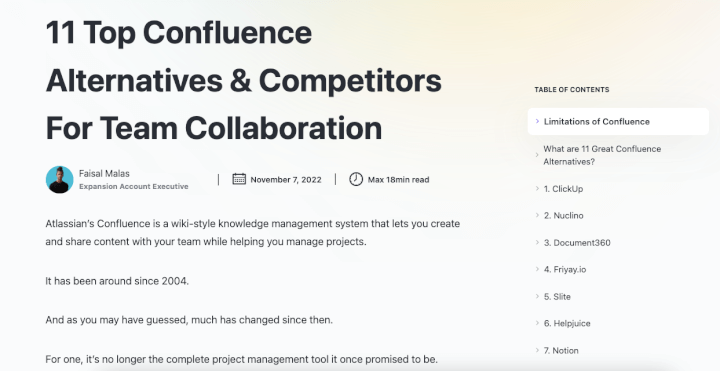
It’s a listicle where they pitched ClickUp as the best alternative to Confluence.
This is an excellent way of showcasing how your product differs (and is even better) from others in the same niche.
Besides this, ClickUp has a unique ‘Product’ page on its blog, sharing case studies, use cases, and more on its product.
In all content pieces, they encourage the users to try out their product, which helps them get product-qualified leads.
2. Airtable’s Content Strategy
Founded in 2012, Airtable is software designed with a vision to revolutionize databases/spreadsheets for people.
And it did, as is evident from the 250,000 companies in its user base.
If you observe Airtable's content strategy and marketing model, you’ll find that the company leverages social media content, podcasts, unique campaigns, and more.
But it is the blog where its content strategy truly shines. Airtable publishes blogs on various topics, targeting different audience personas.
There is another ‘Articles’ section, where you’ll find everything from tutorials and step-by-step guides to how-to articles.
These articles are written to educate the users on various concepts like product design, product management, and Gantt charts, but they make sure to explain how their products can be useful in the context.
Here is an example where they explain how a product roadmap was built using Airtable.
This is a subtle but effective way to promote the product while still delivering value to the reader.
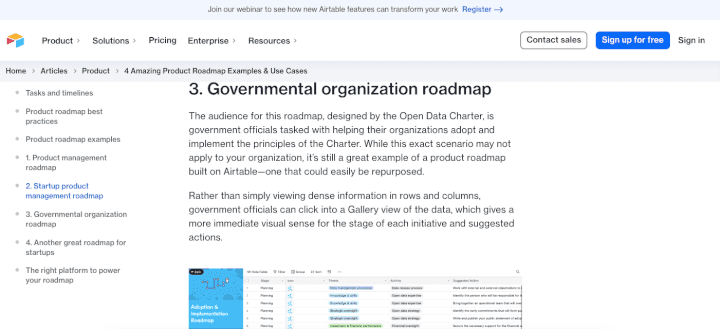
3. Narrato’s Content Strategy
Narrato is a Content Workflow Tool with several great features, like content creation, optimization, collaboration, workflow management, project management, etc.
With a Content Marketplace and a Workspace platform, this PLG company is also unique in the way it leverages content.
If you look at the Narrato blog, you’ll find a wide range of content, from listicles, how-to guides, tutorials, and FAQ posts, to general interest blog posts.
Narrato uses the product-led approach in most of its content. But they make sure to first understand the challenges and needs of their customers so that they can find the right topics to target. Narrato also takes great care in positioning their product appropriately in the context.
Here is an example of a Narrato blog on SEO planning strategy. While explaining keyword research, they suggest using Google Keywords Planner for primary keywords.
They suggest their product feature – the SEO content brief generator – for finding secondary keywords and using them in the content without keyword stuffing.
This is an excellent example of what product-led marketing should look like.
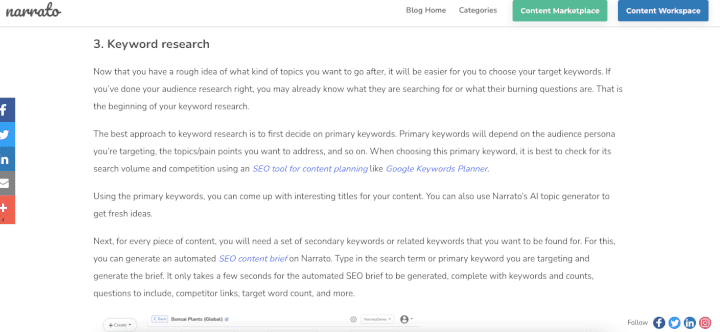
4. Toplyne Labs
Toplyne is a product-led sales platform that surfaces high-intent conversion and expansion opportunities from product analytics tools into the existing CRMs of sales teams. The Toplyne Labs series covers unique insights on what makes PLG businesses tick, what signals make for the best PQLs (Product-Qualified Leads), what sales teams get right, what they get wrong, and more.
Toplyne Labs sources product-led content from anonymized product-usage data from (clickstream events indicative of user-behavior within products) and uses Toplyne’s proprietary AI to bring you insights that can inform the monetization of your PLG product. Insights like:
You might leave up to 70% of your conversions on the table if you ignore your Gmail signups.
Despite accounting for a mere 10-15% of leads, North America accounts for 50% of conversions.
90% of conversions play out by Day 42 of a user signing up 💡
5. Notion’s Content Strategy
Notion is a PLG company that built an all-in-one productivity and collaboration tool that’s great for individuals and teams too. The company is valued at around $10 billion, and has managed to quintuple its user base in just a few years.
Their content marketing strategy is simple – create product-led content that is also customer-centric. Every piece of content released by the company mentions its tool. Since their product has a broader use case, it wasn’t difficult to weave it into most topics. But Notion takes care in making their content customer-focused.
Here is an example of product-led content from the Notion blog, which targets small startups and entrepreneurs building a company. The blog provides valuable insights and tips on breaking company silos and incorporates how Notion can build organization-wide feedback. This is what product-led content marketing looks like in action.
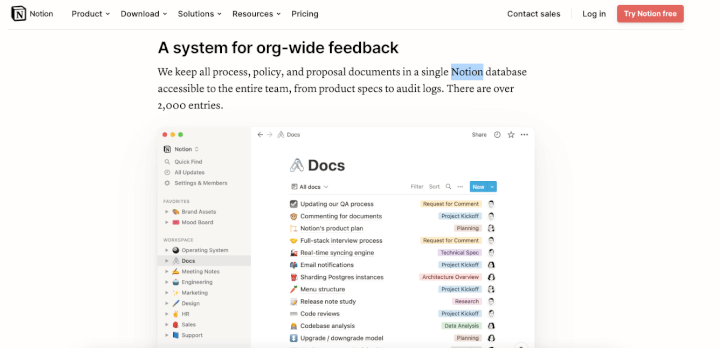
6. HubSpot’s Content Strategy
HubSpot is a well-known name in the content and marketing space.
Founded in 2004, it is a complete CRM tool with great features like email tracking, meeting scheduling, and live chat.
This PLG company recently recorded an ARR of around $1 billion.
Hubspot produces a wide variety of content, including videos, blogs, social media campaigns, podcasts, newsletters, and more.
The company produces a good mix of both customer-centric and product-centric content.
By striking this balance, the company has built itself as the leading information source for content creators, marketers, and entrepreneurs.
Anyone interested in learning more about marketing, sales, customer service, website building, and insights on making more intelligent business decisions needs to look no further than Hubspot Academy.
For example, this article provides a step-by-step guide to creating a marketing plan. They also explain how HubSpot’s tool can build a marketing plan timeline.
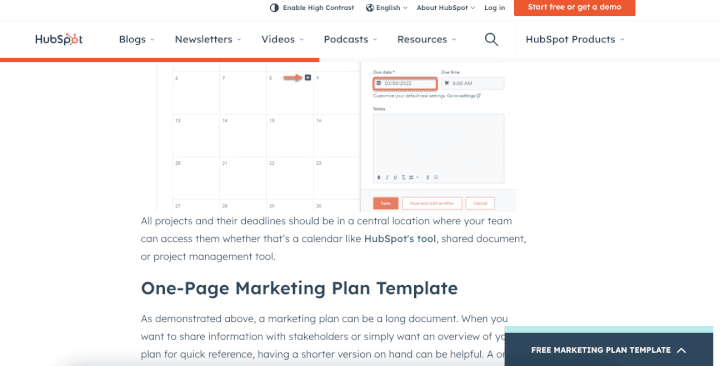
And then, there are other content pieces like this one, where they focus only on providing valuable tips to help their audience achieve a goal.
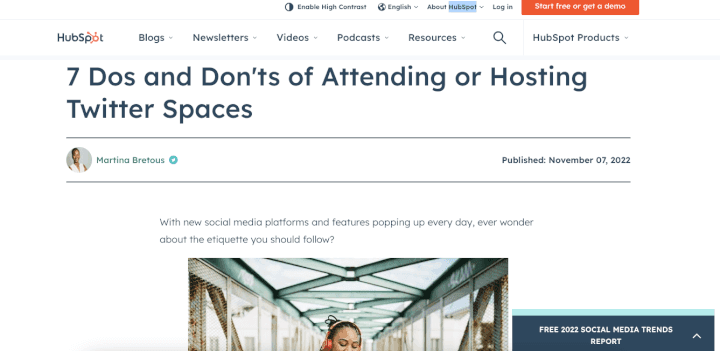
5 Reasons Why You Should Double Down on Content for Your PLG Company
1. Show people how to use your product
Many SaaS companies face a problem because their product is not something physical or tangible.
So, writing bland descriptions of the product features will not do much to drive conversions.
With well-written product-led content, you can "show" your readers how your product will make their life easier.
The point is to help them derive benefits and value, and not harp on your features.
Educate and guide rather than sell.
2. Acquire more product-qualified leads
With the right content strategy, you’ll be able to catch the prospects’ attention early on in their customer journey.
When they see the product in action, they consider your product to be “the” solution for a problem, which encourages them to try it.
Product-led content is a great way to drive organic product-qualified leads - leads with first-hand experience with the product and love it.
3. Supports customer retention
It’s highly likely that many of your existing users are not using your product to its most significant potential.
You can also support customer retention by providing them with helpful content that explains the product's various use cases.
4. Product-led content ties up with free trials perfectly
Product-led content always offers a solution to a customer's pain point.
When a prospect clicks on an article to find a solution to their problem, it’s a perfect context for conversion.
By offering a free trial at this point, you can increase the chances of making a conversion.
5. Helps in gaining a competitive advantage in the industry
Product-led content marketing is somewhat of a well-kept secret.
You can set your product apart from the crowd by leveraging this kind of content. Make the most of this marketing tactic!
Takeaways
By now, you are well-familiar with content marketing tactics leading PLG companies to employ. By applying the valuable insights gained from this article, you, too can achieve product-led growth in no time. Make sure that you deliver value to your audience. At the end of the day, it all comes down to value.
Value helps create engaged readers that are more likely to buy.
Value provides a natural pathway to your prospects to sign up.
Value positions your PLG company as a thought leader in the industry.
Product-led growth (PLG) is in no way a new trend in the SaaS industry.
Many of the leading SaaS companies have been successfully using the PLG strategy for quite some time now.
And this has helped them accelerate and achieve organic growth.
By placing their product front and center and not gate-keeping it, they’ve been able to attract, convert, and retain their customers.
By opening up the floodgates via a freemium or free-trial motion, PLG companies have been able to –
Lower their CACs (customer acquisition costs)
Achieve a higher retention rate
Improve customer satisfaction
Collect critical product usage data
So, what does it take to build an effective content strategy to drive organic growth?
To get to the bottom of this, we examined how some of the most successful PLG companies are leveraging content through product-led content. Let’s dive in.
Content: A Lever for Growth for PLG companies
When it comes to achieving product-led growth, it’s essential to understand that your content needs to drive experience.
The goal here is not just to deliver a message but to deliver something of value to your prospects.
Ideally, your target audience would want to learn something new from the content, with a takeaway that matches their intent.
This not only helps in proving your expertise but also positions your PLG company as a thought leader in the industry.
So, how do you create quality content that delivers value?
1. Narrative
Start by building a narrative around your brand, and apply this narrative consistently across all content forms.
With this approach, you’ll be able to demonstrate your company’s value before you get to the product.
It also helps in building the trust of the audience.
Be sure to keep your ideal customer persona (ICP) and the problem you help solve for them at the center of your narrative.
2. Simplicity
The best way to make your content more attractive to the audience is by keeping it simple.
The problem that many companies end up making is overcomplicating their content, whether in the form of visuals or copy.
It’s always better to strive for simplicity and conciseness when crafting content.
3. Consistency
Every content produced by a company should deliver on the brand narrative.
Even if the content is distributed through different formats, it should have a common thread running through all of it.
If it doesn’t, it can leave your audience confused.
Say your blog post conveys one message, but your landing page says something else.
Without maintaining consistency, you stand the chance of converting your prospects.
Now, let’s look at the examples of a few PLG companies that have managed to do this successfully.
PLG Companies Nailing Content to Drive Organic Growth
1. ClickUp’s Content Strategy
Founded in 2017, ClickUp is a project management platform that has managed to scale the heights of success quickly. This PLG company grew its ARR from $0 to $20 million in just 2 years.
How did it do that? ClickUp built a solid product and hit the nail on the head with its unique content marketing strategy.
If you look at the ClickUp blog, you’ll find that most of the content is product-led, where they’ve discreetly placed their product, guiding the users through its various use cases. But at the same time, they are also ensuring they deliver something of value. Take a look at this blog by ClickUp, for instance –

It’s a listicle where they pitched ClickUp as the best alternative to Confluence.
This is an excellent way of showcasing how your product differs (and is even better) from others in the same niche.
Besides this, ClickUp has a unique ‘Product’ page on its blog, sharing case studies, use cases, and more on its product.
In all content pieces, they encourage the users to try out their product, which helps them get product-qualified leads.
2. Airtable’s Content Strategy
Founded in 2012, Airtable is software designed with a vision to revolutionize databases/spreadsheets for people.
And it did, as is evident from the 250,000 companies in its user base.
If you observe Airtable's content strategy and marketing model, you’ll find that the company leverages social media content, podcasts, unique campaigns, and more.
But it is the blog where its content strategy truly shines. Airtable publishes blogs on various topics, targeting different audience personas.
There is another ‘Articles’ section, where you’ll find everything from tutorials and step-by-step guides to how-to articles.
These articles are written to educate the users on various concepts like product design, product management, and Gantt charts, but they make sure to explain how their products can be useful in the context.
Here is an example where they explain how a product roadmap was built using Airtable.
This is a subtle but effective way to promote the product while still delivering value to the reader.

3. Narrato’s Content Strategy
Narrato is a Content Workflow Tool with several great features, like content creation, optimization, collaboration, workflow management, project management, etc.
With a Content Marketplace and a Workspace platform, this PLG company is also unique in the way it leverages content.
If you look at the Narrato blog, you’ll find a wide range of content, from listicles, how-to guides, tutorials, and FAQ posts, to general interest blog posts.
Narrato uses the product-led approach in most of its content. But they make sure to first understand the challenges and needs of their customers so that they can find the right topics to target. Narrato also takes great care in positioning their product appropriately in the context.
Here is an example of a Narrato blog on SEO planning strategy. While explaining keyword research, they suggest using Google Keywords Planner for primary keywords.
They suggest their product feature – the SEO content brief generator – for finding secondary keywords and using them in the content without keyword stuffing.
This is an excellent example of what product-led marketing should look like.

4. Toplyne Labs
Toplyne is a product-led sales platform that surfaces high-intent conversion and expansion opportunities from product analytics tools into the existing CRMs of sales teams. The Toplyne Labs series covers unique insights on what makes PLG businesses tick, what signals make for the best PQLs (Product-Qualified Leads), what sales teams get right, what they get wrong, and more.
Toplyne Labs sources product-led content from anonymized product-usage data from (clickstream events indicative of user-behavior within products) and uses Toplyne’s proprietary AI to bring you insights that can inform the monetization of your PLG product. Insights like:
You might leave up to 70% of your conversions on the table if you ignore your Gmail signups.
Despite accounting for a mere 10-15% of leads, North America accounts for 50% of conversions.
90% of conversions play out by Day 42 of a user signing up 💡
5. Notion’s Content Strategy
Notion is a PLG company that built an all-in-one productivity and collaboration tool that’s great for individuals and teams too. The company is valued at around $10 billion, and has managed to quintuple its user base in just a few years.
Their content marketing strategy is simple – create product-led content that is also customer-centric. Every piece of content released by the company mentions its tool. Since their product has a broader use case, it wasn’t difficult to weave it into most topics. But Notion takes care in making their content customer-focused.
Here is an example of product-led content from the Notion blog, which targets small startups and entrepreneurs building a company. The blog provides valuable insights and tips on breaking company silos and incorporates how Notion can build organization-wide feedback. This is what product-led content marketing looks like in action.

6. HubSpot’s Content Strategy
HubSpot is a well-known name in the content and marketing space.
Founded in 2004, it is a complete CRM tool with great features like email tracking, meeting scheduling, and live chat.
This PLG company recently recorded an ARR of around $1 billion.
Hubspot produces a wide variety of content, including videos, blogs, social media campaigns, podcasts, newsletters, and more.
The company produces a good mix of both customer-centric and product-centric content.
By striking this balance, the company has built itself as the leading information source for content creators, marketers, and entrepreneurs.
Anyone interested in learning more about marketing, sales, customer service, website building, and insights on making more intelligent business decisions needs to look no further than Hubspot Academy.
For example, this article provides a step-by-step guide to creating a marketing plan. They also explain how HubSpot’s tool can build a marketing plan timeline.

And then, there are other content pieces like this one, where they focus only on providing valuable tips to help their audience achieve a goal.

5 Reasons Why You Should Double Down on Content for Your PLG Company
1. Show people how to use your product
Many SaaS companies face a problem because their product is not something physical or tangible.
So, writing bland descriptions of the product features will not do much to drive conversions.
With well-written product-led content, you can "show" your readers how your product will make their life easier.
The point is to help them derive benefits and value, and not harp on your features.
Educate and guide rather than sell.
2. Acquire more product-qualified leads
With the right content strategy, you’ll be able to catch the prospects’ attention early on in their customer journey.
When they see the product in action, they consider your product to be “the” solution for a problem, which encourages them to try it.
Product-led content is a great way to drive organic product-qualified leads - leads with first-hand experience with the product and love it.
3. Supports customer retention
It’s highly likely that many of your existing users are not using your product to its most significant potential.
You can also support customer retention by providing them with helpful content that explains the product's various use cases.
4. Product-led content ties up with free trials perfectly
Product-led content always offers a solution to a customer's pain point.
When a prospect clicks on an article to find a solution to their problem, it’s a perfect context for conversion.
By offering a free trial at this point, you can increase the chances of making a conversion.
5. Helps in gaining a competitive advantage in the industry
Product-led content marketing is somewhat of a well-kept secret.
You can set your product apart from the crowd by leveraging this kind of content. Make the most of this marketing tactic!
Takeaways
By now, you are well-familiar with content marketing tactics leading PLG companies to employ. By applying the valuable insights gained from this article, you, too can achieve product-led growth in no time. Make sure that you deliver value to your audience. At the end of the day, it all comes down to value.
Value helps create engaged readers that are more likely to buy.
Value provides a natural pathway to your prospects to sign up.
Value positions your PLG company as a thought leader in the industry.
Related Articles




Behavioral Retargeting: A Game-Changer in the Cookieless Era
Unlock the power of behavioral retargeting for the cookieless future! Learn how it personalizes ads & boosts conversions. #behavioralretargeting




All of Toplyne's 40+ Badges in the G2 Spring Reports
Our customers awarded us 40+ badges in G2's Summer Report 2024.




Unlocking the Full Potential of Google PMax Campaigns: Mastering Audience Selection to Double Your ROAS
Copyright © Toplyne Labs PTE Ltd. 2024
Copyright © Toplyne Labs PTE Ltd. 2024
Copyright © Toplyne Labs PTE Ltd. 2024
Copyright © Toplyne Labs PTE Ltd. 2024